When Sun Bowl officials announced that the University of Notre Dame and the University of Miami had accepted invitations to play one another in El Paso, Texas on December 31, 2010, my initial reaction was muted. I was notified of the invitation by a text from a friend. At the time I was sitting in the stands at Lucas Oil Stadium watching Peyton Manning get a headstart on Christmas by gift-wrapping a victory for the Dallas Cowboys. Needless to say, I didn’t at that moment share in my friend’s, “IT’S MIAMI, BABY!” all-caps euphoria. Several thoughts went through my head. Was Miami really the best possible opponent left on the table as opposed to a rudderless ship that had barely limped to a 7-5 record? Was nostalgia trumping rational thought? And oh my God, did Peyton just throw another freaking interception?
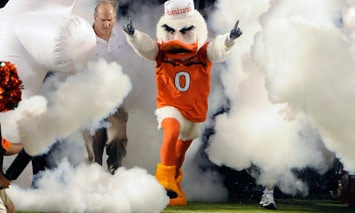
The Colts game ended, and as I walked to my car the adrenaline subsided and I started to gain some perspective. I swallowed down the bitter pill of defeat, looking again at my friend’s text message.
“These two teams aren’t involved in a rivalry. It’s a spectacle. It’s what college football would look like if it were run by championship wrestling promoters.” –John Romano and Randy Cremer, St. Petersburg Times, October 20, 1990
IT’S MIAMI, BABY! In every way that counts, I was raised on the Notre Dame-Miami rivalry. When I was a teenager my father was a close friend of Lou Holtz’s administrative assistant, and so I was afforded a personal entrée into Notre Dame football most kids (and adults) only dream of. While some ND fans made it a point to attend at least one Notre Dame game every year, my father and I attended, as far as I can remember, nearly every home game from 1979 through 1991. People forget that early on in the ND-Miami series the Hurricanes were little more than glorified tackling dummies for the Irish. Hampered by a chronically mismanaged and underfunded athletic department, Miami was flat-out embarrassed by ND from 1971 through 1980, losing 10 consecutive games by an average margin of 33-10.
But then came Howard Schnellenberger. And then came Jimmy Johnson. From 1981 through 1987 Miami beat Notre Dame five times in six tries; in those five victories, the Canes’ average margin of victory was 34-6. While Faust obsessed about player’s curfews and changing the team colors from navy to Madonna blue, Schnellenberger and Johnson locked down the Miami-Dade County talent pool and never looked back. Like most Notre Dame fans, I didn’t watch so much as endured the ’85 game, the infamous 58-7 blowout in the Orange Bowl. Unlike most Notre Dame fans, I really wished Ara Parseghian would have just shut up during the broadcast. If the Notre Dame defense didn’t want the Canes to run up the score, then they should have played better, and the last thing I wanted to hear was an Irish legend begging for mercy on national television.
“We hated Notre Dame, they hated us.” –Alonzo Highsmith, Miami running back, 1983-1986
For sure, Notre Dame has its historic rivals: USC, Michigan, Michigan State, Navy, Army, Purdue, etc. But no other team, at least in my living memory, has spawned such venom and personal offense as the Miami Hurricanes. To me, the 1980s were about John Hughes films, Reaganomics and hating the Miami Hurricanes. The Canes were the Soviet hockey team of college football, the team whose fortunes were tied not to hard work on the field and in the classroom, but to money under the table from gold-toothed rap artists, skipping school and a pact with Satan. (Granted, the Beelzebub connection was unconfirmed, but as an Irish true believer I did not question its validity.) I hated the Canes. I thought they were evil incarnate. I wasn’t just upset when Miami beat Notre Dame, I was upset when Miami beat anyone. I was upset when Miami got a first down against Rice or San Jose State. The smallest positive moment for the Canes didn’t just piss me off, it made me question the very existence of God. I didn’t want to hear the stories about these kids being raised up from abject poverty to NFL superstardom; I wanted to know why their hardscrabble lives didn’t impress upon them so much as an ounce of humility or respect for others. Michael Irvin, Brian Blades, Alonzo Highsmith, Randall Hill: these guys were preening thugs first and players second
“I turned around and said, ‘Get the f*ck off the field.’ [Leon Searcy] turned around and said something derogatory to me, and then I said something back, and then maybe one of us said something like ‘Your mom…’ and then I punched him right in the f*cking throat.” –Ned Bolcar, Notre Dame linebacker, 1986-1989
“Catholics vs. Convicts” t-shirts, Notre Dame students giving out Jimmy Johnson’s personal phone number, the brawl in the tunnel: this was the atmosphere for the 1988 game. The buzz in Notre Dame Stadium wasn’t just palpable, it was visceral. My seats were in Section 11, right on the 30-yardline. Populated by mostly older alum and a smattering of the opposing team’s fans, Section 11 had a reputation for being a little on the sedate side. I’m pretty sure the phrase “down in front” was invented in this section.
On October 15, 1988, everyone in Section 11 lost their voices by roughly the middle of the second quarter.
The history books tell the story far better than I can. For once, the Game of the Century lived up to the hype. We all witnessed the de facto national championship game that day, a 31-30 epic that remains the greatest sporting event I have ever personally attended. A scalper offered me and my father $1,000—for each, not both, of our tickets. When we finally got back from South Bend late that night, a VHS tape sat on our front porch with a note from our neighbor: “Thought you might like to re-live the magic.” My father and I stayed up until 3 AM re-watching every second of the game. We rewound the Pat Terrell deflection probably 20 times.
There would be two more games in the series, a 27-10 Miami win in the Orange Bowl in 1989 and then a 29-20 victory by the Irish back in South Bend in 1990. As the curtain closed on the ‘90 game, Jim Nantz’s signoff was short but sweet: “For college football fans, it’s a pity this rivalry has ended.”
The ND-Miami rivalry still had its moments, even without the teams playing one another. In 1994, the Miami Herald broke a story alleging that boosters offered bounties to knock opposing players out of games, specifically Tony Rice and Rocket Ismail.
“…former [Miami] players who had gone to the NFL would provide money from a pot—bounties, essentially—for big hits and plays during key games … Hurricanes celebrity booster Luther Campbell, lead singer of the rap group 2 Live Crew, offered $1,500 to whoever could knock Tony Rice out of the contest and $1,000 if someone could dispose of Rocket Ismail.” –Jeff Carroll, Perfect Rivals: Notre Dame, Miami, and the Battle for the Soul of College Football
After this incident, administrators from both schools pretty much backed away from the rivalry entirely, fearing it had become too contentious. Miami gave way to Florida State in the eyes of Notre Dame fans, most of us viewing the Hurricanes and Seminoles as near-clones of one another, never mind that Lou Holtz and Bobby Bowden were dear, life-long friends. But ultimately, the close of the ND-Miami series became a harbinger of tough times for both programs.
Lou left Notre Dame at the end of the ’96 season just as Miami was being hit with crippling NCAA sanctions in the aftermath of the Pell Grant scandal. In 1997 the teams that had essentially played for the national championship in three consecutive seasons from 1988-1990 went a combined 12-12. Miami would enjoy a return to greatness under Butch Davis and Larry Coker, winning the 2001 national championship and compiling an astounding 46-4 record from 2001 through 2004. But much like Notre Dame’s 15-year post-Lou death spiral, Miami has more recently been stuck in neutral at best—a great program laden down by mediocre administrators and even worse coaching hires. In July of 2010 both programs were in disarray. After 11 years of Lou Holtz, Notre Dame was on its fifth head coach in 14 years. At Miami, Coach Randy Shannon was on the hot seat. And yet, for a brief moment, all that seemed to just go away with the announcement that Notre Dame and Miami had signed a new three-game series that would begin in 2012.
The 2010 season trumped this announcement, as 7-5 seasons rife with injuries and bone-headed coaching decisions tend to do. By season’s end, however, Notre Dame and Miami were trending in completely opposite directions. Coach Brian Kelly had turned around a season that most ND faithful had written off, raising his team up from personal tragedy and a string of last-second losses to end the year on a three-game winning streak against the likes of nationally ranked Utah, the best Army team in 14 years and of course, Southern Cal. Coach Shannon had taken a team with 12-0 talent and coached them to an uninspired, underachieving seven wins, including a painful season-ending home loss to South Florida in front of a half-empty stadium. Kelly was sainted, Shannon was fired.
“The best time of the season was when there were only forty-five second left in the Miami game. It had come down to the final seconds, and I wasn’t scared. I was confident. Coach had all of us confident. I came to Notre Dame for games like that … One of the great moments was all of us holding up our helmets after the Miami game and telling each other we loved each other.” – Chris Zorich, Notre Dame defensive tackle, 1987-1990
And so we’ve arrived at this moment. The Hyundai Sun Bowl on December 31, 2010. Last year’s game between ranked Stanford and Oklahoma sold out in two weeks, an all-time record in the 76-year history of the Sun Bowl, college football’s second-oldest bowl game. The Notre Dame-Miami game sold out in 18 hours. And while a team without a coach tends to be more disinterested than dangerous, Miami comprises probably the most talent Notre Dame will have faced all year, with a stout passing defense that will make true-freshman QB Tommy Rees pay for playing as poorly as he did against Southern Cal. My heart says Notre Dame wins this game. My head says we still haven’t closed the talent gap enough to do it.
There are still plenty of stories left to tell. Even for the current generation who has no recollection of the ND-Miami rivalry, there are plenty of chips on people’s shoulders. Notre Dame’s starting nose guard Ian Williams was recruited by Miami only to be told he was too small. Robert Hughes was a Miami fan growing up, was a 4-star running back out of high school with offers from ND, Michigan, Ohio State and Wisconsin and was completely snubbed by the Canes’ recruiting staff. Miami senior cornerback Ryan Hill has already said, “It’s not a BCS championship, but when you put Miami and Notre Dame together, we’re not going there to lose, point blank, period.”
It’s not a BCS Championship, but it is a spectacle. The naysayers will say this is a game of 7-5 teams—nothing more, nothing less. They’re hoping you don’t pay attention to the record ticket sales. They’re hoping you don’t notice the Sun Bowl exceed the television ratings of all but maybe two BCS bowls this college post-season. They’re hoping Notre Dame and Miami won’t rise from the ashes.
“You have an afternoon to play, a lifetime to remember. But I want you to do one thing: You save Jimmy Johnson’s ass for me.” –Lou Holtz, Notre Dame head coach, 1986-1996
I don’t know about South Beach, but South Bend is just about ready to shut those people up.
IT’S MIAMI, BABY! GO IRISH! BEAT THE CANES!
(Sources used for this article include The Fighting Spirit: A Championship Season at Notre Dame by Lou Holtz with John Heisler; Perfect Rivals: Notre Dame, Miami, and the Battle for the Soul of College Football by Jeff Carroll; and ESPN Films 30 for 30: The U, Dir. Billy Corben)
McSweeney is a longtime blogger and poster on UHND. His e-novel, EXOTIC MUSIC OF THE BELLY DANCER, a coming-of-age story about sex, drugs, rock n’ roll, and Notre Dame football, is available on Amazon by clicking here and at Barnes & Noble by clicking here.
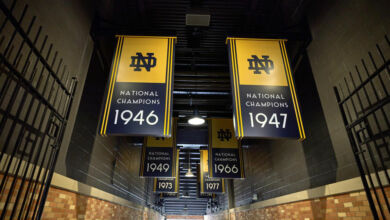
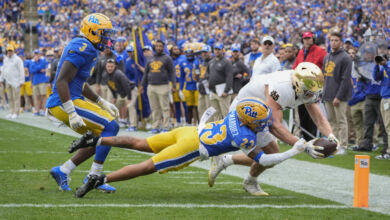
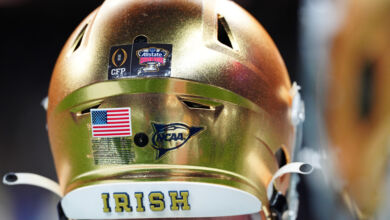
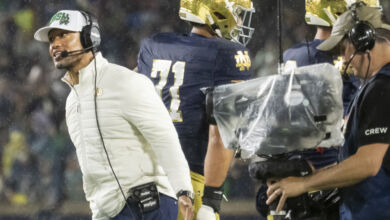
Did you know Miami had more Catholics in it’s team that year than Notre Dame? And, yes, my entire family went to ND. My son is currently at Miami.
Damn. Always count on Mac to get me fired up. Now here I am 3 days before Christmas and am I thinking “peace, love and goodwill toward men”? Hell no. I’m thinking of how much I would like to kick Jimmy Johnson in the nuts. So much for the Christmas spirit. Mac has replaced it with the “blood makes the grass grow kill kill” Irish fight. GO IRISH!
(PS: My prediction, South Bend 24 South Beach 10).
“…Save Jimmy Johnson’s ass for me.” What??!! Love it. Can’t wait for the 31st. Go Kelly! Go Irish! Show Miami and Al what it really means to be “Golden”!!!
bolcar prichett and stonebreaker were unbelievable studs
I remember that ass kicking we received in 85 i was embarassed by our whining. Don’t blame a team for dominating you….get better and man up. I blamed ourselves. Let’s pay them back and listen to the lamentations of their women, with a smile on our faces….like Conan would.
Go Irish!!!!!!!!
Notre Dame quit in the first quarter in 1985 and didn’t try, Ara should have realized that and not whined like he did
Great read, Mac. I’m ready to kick Miami’s ass.
Long time reader, finally a member. This is the type of stuff that makes me wanna be here. Great Article, love this site. @#$%^&*( Miami!
Great article and even better to read.
explain please? its like saying “great TV show, and even better to watch”… makes no sense.
why do you care?
I don’t, I’m confused.
Thanks, McSweeney! Always a pleasure. Have a Merry Christmas and an especially Happy New Year’s Eve!
I love Ned Bolcar’s quote….let Calabrese read that!!! That’s the the type of tough SOB the Irish need all over the defense!
“I punched him right in the f’n throat!”………..LOVE IT!!!!!!